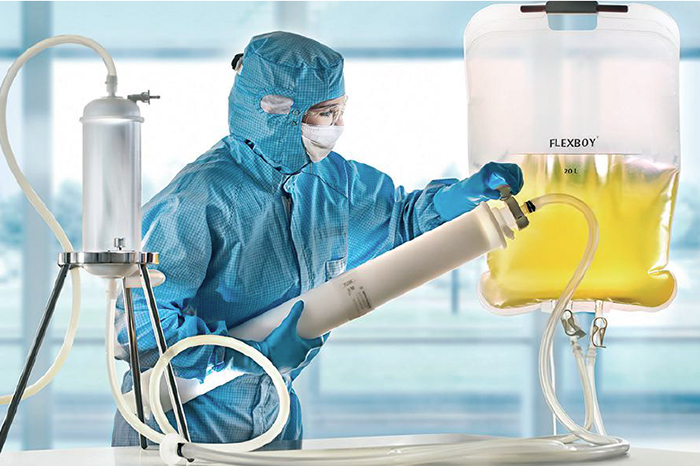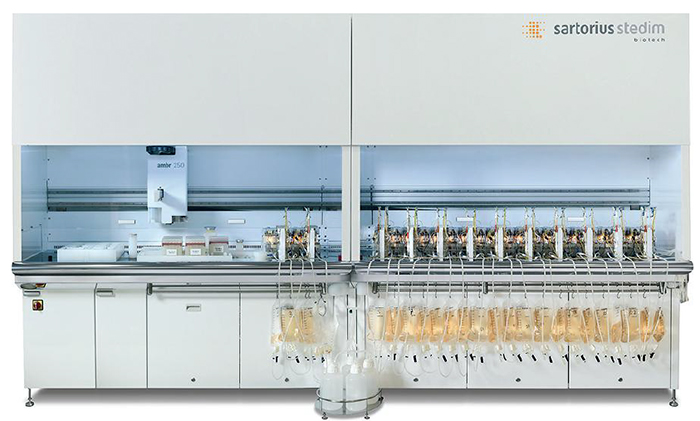Viral Vector Development, Manufacturing, And Process Intensification
By Miriam Monge, Amélie Boulais, and Gerben Zijlstra

Originally published by BioProcess International
On 23 April 2018, Sartorius Stedim Biotech (SSB) hosted a seminar for viral vaccine manufacturers at the Novotel, Amsterdam, the Netherlands. The seminar featured three guest presentations from ABL Europe, Janssen Vaccines, and the Max Plank Institute, Magdeburg. These external presenters spoke alongside experts in vaccine processes and process intensification from SSB. The aim of the seminar was to provide an overview of the tools and technologies available for development of viral vectors and to provide insights into techniques that viral vector manufacturers can use to intensify their production processes to achieve greater productivity.
During her opening remarks, Miriam Monge (Director of Marketing Integrated Solutions, SSB) highlighted the fact that single-use technologies can significantly reduce capital costs and decrease the consumption of energy and water during vaccine production. SSB is focusing on improving the robustness of these single-use technologies so that vaccine manufacturers can apply them during commercial production and benefit from lower costs, greater flexibility, increased speed, and higher quality.
Edwin Janssens from the Janssen Vaccines Process Development group described a design of experiments (DoE) approach for characterizing a viral vaccine purification step using a Sartobind membrane adsorber (Photo 1). He explained that adopting a quality by design (QbD) approach is consistent with regulatory expectations because it decreases reliance on end product testing but is also a smart way for manufacturers to generate process knowledge. The QbD approach is underpinned by the principle that manufacturers should start by defining the desired quality attributes profile of the product they are developing and then determine the inputs, such as material attributes or processes parameters, which will deliver that output.

Janssen Vaccines applied the QbD approach to the characterization of processes for some of its vector-based products. One of the SSB Sartobind membrane adsorbers is used as part of the purification process. Janssen Vaccines uses it in a bind-and-elute mode because some of the company’s vector-based products have a negative charge. The Sartobind family of membranes also come in small-scale formats that facilitate the DoE approach because a large number of experiments can be performed with little starting material.
Janssens explained that manufacturers should start the QbD process with a risk assessment to decrease the number of conditions that must be screened without excluding parameters that can affect the output profile. Successful completion of the risk assessment allows the design of screening experiments and the ranges of the parameters being studied. Manufacturers also must decide what constitutes a critically important parameter based on their control strategy and other factors. The statistical software that scientists use to analyze the results may identify parameters as being critical, but manufacturers should ensure that they can provide a scientific justification for that designation. Those factors deemed noncritical or minimally critical might be removed from the subsequent augmented experimental design that allows all the possible interactions between critical parameters to be understood. From the results of the augmented experimental design, manufacturers can establish proven acceptable ranges for critical process parameters and material attributes. Janssens concluded that the QbD approach demands creativity from an experimenter and requires that person to make choices throughout the process. The amount of knowledge gained about the process makes this approach well worth the effort.
Anthony Da Silva and Morgane Larret from, ABL Europe described development of a flexible, multiproduct, multicustomer unit for viral vector production. ABL Europe is a contract manufacturing organization that is 100% dedicated to viral vector production. At the beginning of 2016, the company had one filling suite, one drug substance suite for adherent cell processes, and a stainless steel drug substance suite initially designed for adenovirus production. The company decided to invest €3 million to expand production capacity by modifying and converting the stainless steel suite to incorporate entirely single-use equipment from vial thaw to drug substance storage. The new suite would allow the production of AAV, adeno, lenti and other viral vectors that can be produced from nonadherent cell lines. ABL Europe needed the suite to accommodate viral vector production up to the 500-L scale. The company wanted to select as many pieces of equipment as possible from a single supplier to reduce vendor management risks, reduce supply chain complexity, facilitate integration of different process steps, and simplify future support requirements from the vendor.
ABL Europe contacted four suppliers initially and ranked them according to criteria such as the technical solution they provided, costs, and company expertise. Two suppliers were shortlisted to demonstrate their technology at their own facilities. ABL Europe selected SSB as the main supplier at the beginning of 2017. SSB offers compact and flexible equipment that can be shared by different steps. It provides a wide range of suitable processing technology that can be operated as a closed system to allow production of nonfilterable viral vectors. Different pieces of SSB equipment use harmonized software, which minimizes operator training requirements. The company also promotes a 500-L single-use bioreactor that ABL Europe might choose to purchase in the future.
ABL Europe’s new single-use production line for viral vectors from suspension cultures comprises orbital shakers, rocking motion, and stirred tank single-use bioreactors from SSB and the XCell ATF6 from Repligen. There are separate production areas for production of cells and viruses. The downstream process uses single-use mixers, two crossflow systems, and a cell harvest system, all from SSB. Chromatography steps are run on an ÄKTA Ready from GE Healthcare. The equipment was delivered, installed, and qualified by the middle of 2017, and the suite was available for use in November of that year.
ABL Europe’s state-of-the-art viral vaccine facility is fully compliant with EU good manufacturing processes (GMPs), can produce up to 20 batches of drug substance each year, and can be expanded further by adding a 500-L single-use bioreactor. It allows closed system processing and has a disposable production line. It will support projects that require batches for preclinical studies, clinical phases 1 to 3, and validation.
The need to intensify viral vector production was discussed during the workshop. Felipe Tapia (Max Planck Institute, Magdeburg, Germany) spoke on intensified and continuous vaccine manufacturing processes as part of the scientific activities carried out in the bioprocess engineering group of Prof. Dr.-Ing. Udo Reichl. He believes that the gene therapy industry needs process intensification techniques to realize its full potential regarding the high-dose input required. To achieve very high titers and sufficient vector quantities is labor intensive and demands very careful process optimization for both clinical phase 3 trials and commercial production.
Tapia explained that manufacturers of viral vaccines should consider whether to produce in batch, semicontinuous, or continuous modes. Companies that seek to move away from conventional batch production need to ensure that the cell-specific virus yield, virus quality, and stability are maintained during process intensification.
The upstream processing team at the Max Planck Institute, led by Dr. Yvonne Genzel, have used perfusion to increase the concentration of cells in the bioreactor before infection. An interesting finding was that the filter retention devices with larger membrane cutoffs allowed more virus to be retained within the bioreactor. This possibly could be due to a fouling phenomenon of the hollow-fiber membranes. The team showed that an ATF system could be used as a retention device to intensify cell culture during production of influenza A virus. With this set-up, the increase in cell concentration did not reduce the cell-specific virus productivity and therefore led to a 14-fold increase in titer, a twofold increase in volumetric productivity, and a twofold increase in cell-specific virus productivity.
Tapia and his colleagues also experimented with multistage bioreactors for continuous production of influenza viruses. One stirred-tank bioreactor is used for cell growth while another one or two stirred tank bioreactors are used for virus infection and production. Each bioreactor is perfused with fresh medium, and the virus product is collected continuously. The team found that although this could be an efficient production system for genetically stable viruses, the titer could oscillate over extended times if defective interfering particles accumulate. Furthermore, the increase in virus passage number could lead to unwanted viral mutations.
To address these issues, the team developed a plug-f low bioreactor to provide a constant supply of viruses with a defined passage number and with no oscillation in titer. A stirred-tank bioreactor, operated as a chemostat, continuously provides cells. The system infects those cells and injects air bubbles into the medium before the cells enter the plug-f low reactor. The air bubbles provide enough oxygen for the subsequent virus replication phase. Engineers from the Max Planck Institute have used this technique with suspension MDCK cells, which take around 20 hours to pass through the 100-m long reactor. Flow is laminar in this first reactor prototype, which has an internal diameter of 1.5 mm and a flow rate of 12 mL/h. The team expects that virus manufacturers could use a 50-L stirred-tank bioreactor to feed the plug-f low bioreactor with cells at a rate of 1.2 L/h, allowing 1,000 L of harvest to be produced over a 35-day period.
SSB has invested in a range of new technologies to support the biopharmaceutical industry in its attempts to intensify bioprocesses. Many of these technologies are applicable to the viral vector sector. They range from development tools such as the ambr 15 with new centrifuge inserts that allow it to be operated as a perfusion mimic and the ambr 250 high throughput perfusion (Photo 2) that enables development of perfusion processes with up to 24 bioreactors operated in parallel with fully automated liquid handling. Gerben Zijlstra (Continuous BioManufacturing Platform Marketing Manager, SSB), described the company’s process-scale technologies including rocking motion bioreactors with integral cell separation filters for n – 1 perfusion and the kSep centrifuge for the harvest of high-cell-density cultures. He explained that customers have used rapidly cycled membrane adsorbers to achieve high productivities in a simple and efficient format.

Amélie Boulais (Vaccine Platform Marketing Manager, SSB), believes that the scalability of the portfolio is critical. “Many companies that are in the early stages of developing viral vectors are not thinking about how their processes will scale-up and the process economics of the final process. What works at the preclinical stage may not be suitable for producing sufficient product for phase 3 clinical trials and a subsequent product launch. Sartorius has a range of innovative upstream and downstream processes that are scalable but also can accelerate development of new viral vectors. Crucially, we support customers with a range of development, process modeling, validation, and engineering services that will help customers with viral vectors commercialize their products successfully and that ensure innovative and life changing medicines are delivered to the patients that need them so urgently.”
Corresponding author Miriam Monge is Director of Marketing Integrated Solutions at Sartorius Stedim Biotech; miriam.monge@sartorius-stedim.com. Amélie Boulais is Vaccine Platform Marketing Manager, and Gerben Zijlstra is Continuous BioManufacturing Platform Marketing Manager at Sartorius Stedim Biotech.
